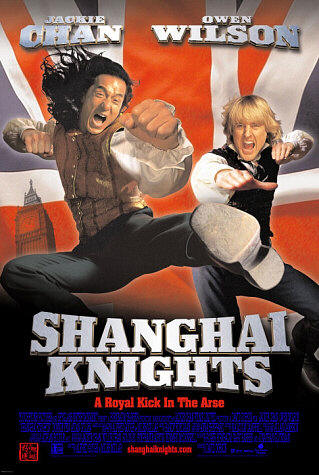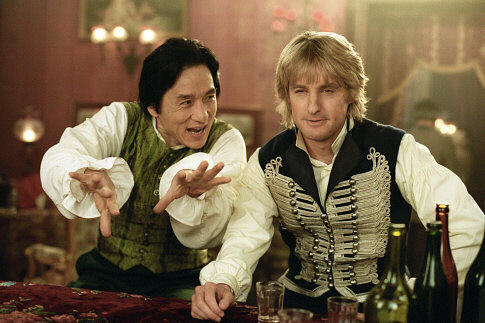Shanghai Knights
Reviewed by Rich Drees

A majority of the fun of any buddy movie is watching the mis-matched pair of leads overcome their differences to become friend by the time the credits roll. That’s also the curse that most sequels to buddy films have to overcome. Once they’re friends, where does the conflict between the two come from?
Well, the creative forces behind Shanghai Knights, the sequel to the cowboy kung-fu buddy flick Shanghai Noon, have done is hit the “Reset” button, in a manner of speaking, splitting the heroes and giving them a interpersonal small obstacle to overcome before getting onto the business at hand of stopping the bad guy.
As Knights opens, former Forbidden City guard Chon Wang (Jackie Chan) is serving as the sheriff of Carson City. His heart still belongs to Princess Peipei (Lucy Liu, from the first film, but who does not appear here) though she is living in San Francisco. When he receives word that his father has been murdered and his sister has followed the culprit to England, he sets off to New York to collect his old partner Roy O’Bannon (Owen Wilson) who was supposed to be investing their reward money from the first film. Needless to say, Roy has lost all the money and the two are forced to scam there way to London. Once there, they team up with Chon’s sister Chon Lin (Fann Wong), a street urchin named Charlie (Aaron Johnson) and a bumbling Scotland Yard inspector (Tom Fisher) to stop a plot that threatens the royal families of both England and China.
 Chan and Wilson have an easy chemistry on screen that is much more enjoyable
to watch than Chan’s pairing with Chris Tucker in the Rush Hour
films. (Let’s face it, a little Chris Tucker can go a long way.)
Fortunately, the filmmakers quickly resolve any amenity over Roy’s loss of
their money early on, in order to make way for the plot.
Chan and Wilson have an easy chemistry on screen that is much more enjoyable
to watch than Chan’s pairing with Chris Tucker in the Rush Hour
films. (Let’s face it, a little Chris Tucker can go a long way.)
Fortunately, the filmmakers quickly resolve any amenity over Roy’s loss of
their money early on, in order to make way for the plot.
The action and stunt work is easily the best out of all of Chan’s American films to date. Perhaps it’s the historical setting that inspired Chan and his crew to stage some fight sequences that may not top his penultimate work in Drunken Master II, but certainly recall it.
Chan also gets to pay tribute to the silent comedies that he has admitted have been an influence. Early on there’s an imaginative fight sequence with some very Keystone Kops-esque police officers in a revolving door as well as a nod to a famous Harold Lloyd moment in the film’s climax. There’s also a fight in a London street market where Chan uses numerous umbrellas, which recalls a standard trope in the many Hong Kong films about Wong Fei-hung, a Chinese Robin Hood figure. (Chan portrayed Fei-hung in the two Drunken Master films.)
Unfortunately, there is a drawback to the historical setting and that’s screenwriters’ Alfred Gough and Miles Millar insistence on overloading the script with cameos by historical figures. The few anachronistic jokes in the first film were fine. However, the number here just distracts from the overall flow of the movie, with the more labored ones detracting from the cleverer ones.